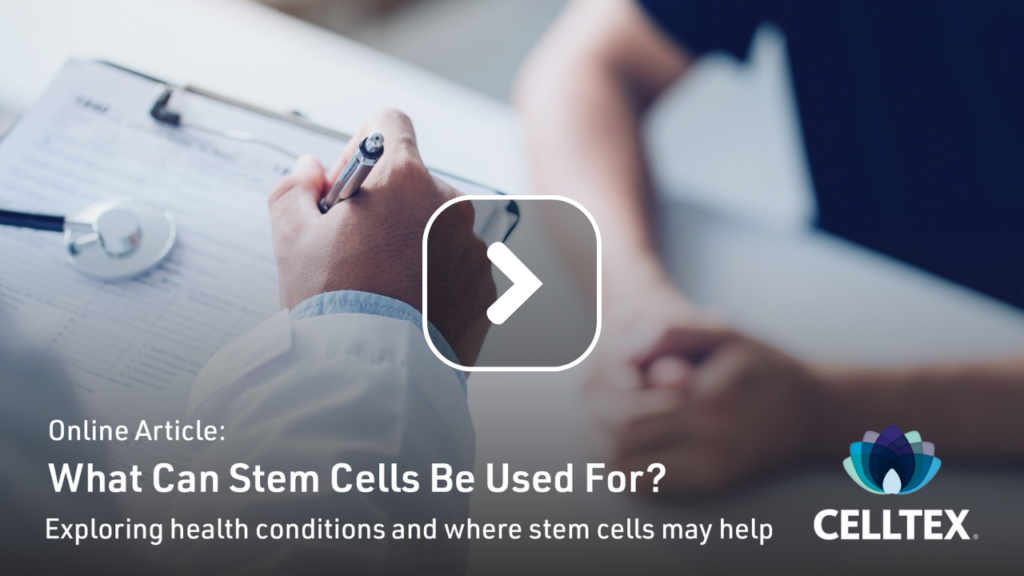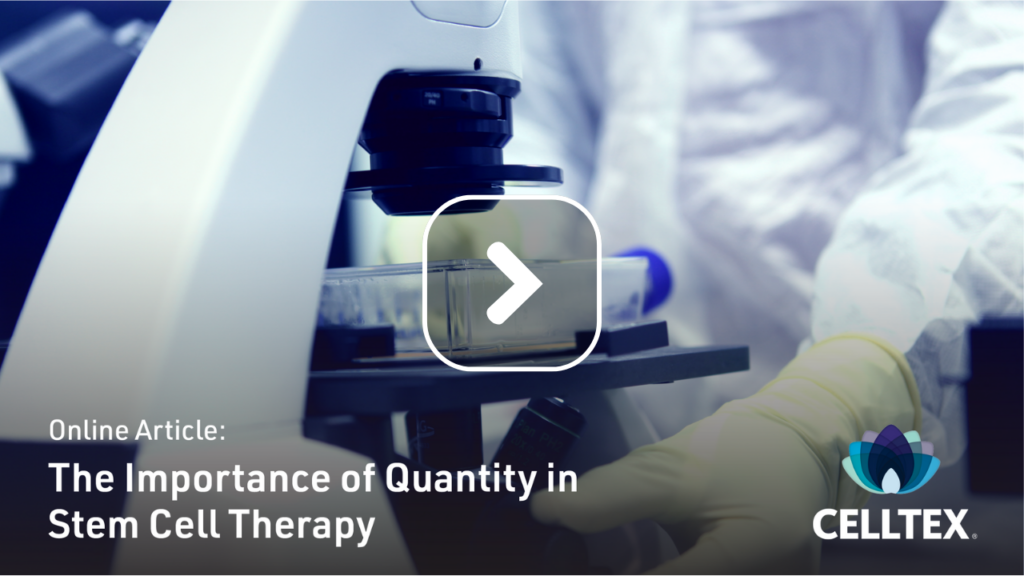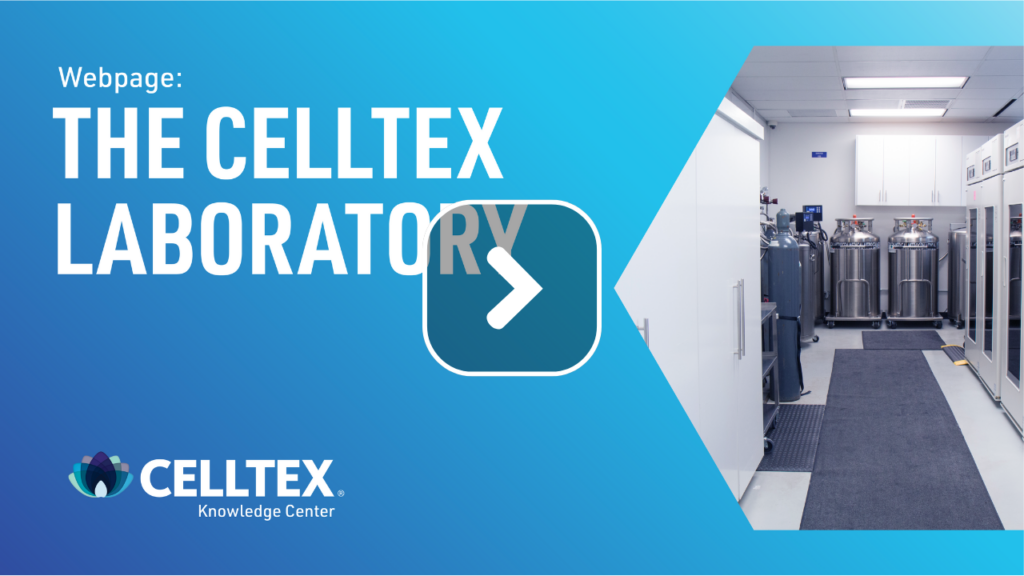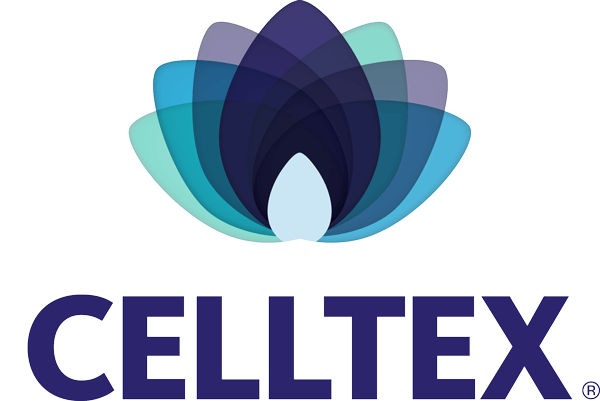Celltex News
The Difference Between Cord Blood Banking and Adult Stem Cell Banking

Matthew Farrow was not expected to live long. He was born with Fanconi Anemia (FA)—a rare genetic disorder characterized by hematological (blood system) abnormalities that often lead to bone marrow failure and/or cancer. Farrow was doomed to develop life-threatening infections (due to poor WBC development/numbers); experience chronic fatigue, weakness, and/or shortness of breath (due to poor RBC development/numbers); and have bleeding issues (due to platelet defects). Further, due to the underlying cause of the FA (an impaired DNA damage response), he would be more likely to develop life-threatening cancers, particularly leukemias. [1, 2]
If Farrow didn’t receive a bone marrow transplant (BMT), he was likely to experience complete bone marrow failure by age ten and die. [1, 2]
There was just one major problem: Although hematopoietic stem cell transplantations (bone marrow transplants) had been performed since 1957, a suitable bone marrow donor could not be found for Farrow. BMTs (or hematopoietic stem cell transplantation (HSCT)) require donors to be close Human Leukocyte Antigen (HLA) matches to the recipients. The HLA genes encode proteins found on the surface of most cells in the body and play a critical role in the immune system by helping it distinguish between the body’s own cells and foreign invaders. As with all BMT and organ transplant candidates, Farrow needed a potential donor to have a matching HLA type to reduce the risk of rejection and complications like graft-versus-host disease. [3]
The Emergence of Cord Blood Transplantation
Enter umbilical cord blood (UCB) as a solution. In the mid-1970s, UCB was recognized as a promising resource for harvesting HSCs, which can differentiate into various types of blood cells. Due to its immunological immaturity, cord blood poses a lower risk of rejection and requires less stringent matching than bone marrow. [4, 5]
But in 1988, when Farrow was six, the procedure of using umbilical cord blood for a stem cell transplant instead of bone marrow was considered wildly experimental. Faced with no alternative other than certain early death for their son, Farrow’s parents decided to move to Paris—home to Dr. Eliane Gluckman, a hematologist and cord blood expert who would go on to pioneer the use of cord blood for stem cell transplants. At Hospital Saint-Louis in Paris, Dr. Gluckman saved Farrow’s life, having successfully performed the first cord blood transplant. Farrow’s marrow had a new lease on life.
Advantages of Cord Blood Stem Cells
The cord blood collected from the umbilical cord (UC) and placenta shortly after birth contains HSCs similar to the HSCs found in bone marrow. The UC-derived HSCs are multipotent (capable of developing into multiple blood cell types), self-renew, and can be used in the clinic to treat various diseases. Most commonly, UC-derived HSCs are used to restore bone marrow function following myeloablation, a procedure that destroys bone marrow cells to make way for healthy cells in cases of leukemia or other conditions. [6, 7]
Harvesting stem cells from umbilical cord blood offers numerous advantages over bone marrow. UC-derived HSCs are easier to collect and pose no risk to the mother or newborn—a syringe needle is used to collect the HSC-rich blood from the umbilical cord after birth. Additionally, the UC-derived HSCs have faster processing times, lower costs, and decreased risk of infection transmission. Cord blood also requires less stringent HLA matching, making it easier to find compatible donors. [7, 8, 9]
In fact, the cord blood of Farrow’s younger sister, Allison, was a suitable match for Matt, even though her bone marrow was not considered a viable option. [1, 2]
This is because bone marrow transplants typically require a much closer HLA match than umbilical cord blood transplants. The lower immune reactivity of umbilical cord blood cells reduces the likelihood of complications like graft-versus-host disease. [8, 9, 10]
The Evolution of Cord Blood and Tissue Banking
Realizing the potential benefits, private biomedical companies quickly sought to capitalize and expand on the success of early cord blood transplantation. The first private cord blood bank in the US—Cord Blood Registry—opened in 1992. Private cord blood banking allows families to store umbilical cord blood for future medical use. It gives parents access to their newborn’s cord blood stem cells if needed for transplants or other treatments for the child, a closely-matched sibling, or a relative.
Cord Blood Registry was also the first U.S. private cord blood bank to add cord tissue banking to its list of offerings, and nearly every other private cord blood bank in the country has followed suit. [11]
Unlike cord blood, umbilical cord tissue contains Mesenchymal Stem Cells (MSCs), which have the potential to differentiate into a wider variety of tissue types, such as bone, cartilage, skin, and vascular endothelial cells.
There are dozens of private cord blood and tissue banks. Millions of soon-to-be parents have been approached by nurses, midwives, OBGYNs, or sales representatives with a prenatal sales pitch that sounds something like this:
“Congratulations on your growing family! As you prepare for your baby’s arrival, consider the incredible opportunity to bank your newborn’s umbilical cord blood. Cord blood is rich in life-saving stem cells that can treat over 80 serious medical conditions, like blood disorders and certain cancers such as leukemia and anemia. By storing it privately, you’ll have a guaranteed, genetically-unique resource that could potentially protect your child or a family member. It’s a once-in-a-lifetime opportunity to invest in your family’s health and peace of mind.”
It’s no wonder that by 2022, up to four million units of umbilical or placental cord blood have been collected and housed in private cord blood banks. [12]
The Potential Shortcomings of Cord Blood and Tissue Banking
A July 2024 investigation published in the New York Times revealed several concerns regarding the practicality of cord blood and tissue banking: limited therapeutic potential, low usable cell volume, and bacterial contamination risks.
Despite marketing claims suggesting cord blood can treat a wide range of diseases, the reality is that it is rarely used. Since 2010, only 19 transplants using a child’s own cord blood have been documented, and just one such transplant was reported in 2023, making it an unlikely therapeutic option in most cases. [13]
Furthermore, parents are not always aware that banked cord blood cells cannot be used to treat leukemia in the same child from where the cord blood came from, as those stem cells already have a marker for precancerous cells. [13]
Additionally, the investigation uncovered that many stored cord blood samples were rendered unusable due to contamination or an insufficient volume of stem cells in the sample.
Despite these concerns, cord blood and tissue banking can still be beneficial. For instance, cord blood banking may be appropriate in cases when a sibling or family member may need a stem cell transplant for a blood-related condition.
However, as the NYT investigation mentions, advancements in regenerative medicine have “led many doctors to abandon cord blood in favor of adult stem cells.” [13]
Adult Stem Cell Banking: Eliminating the Concerns of Cord Blood Banking
Unlike cord blood banking, which must be done roughly within 15 minutes after birth, adult stem cell banking allows individuals to store their own stem cells at any age. This process typically involves collecting stem cells from a person’s adipose (fat) tissue or bone marrow (the former is typically less invasive), which are both rich sources of Mesenchymal Stem Cells (MSCs). MSCs are unable to differentiate into blood cells like HSCs. However, they can be used in a much more comprehensive range of clinical applications.
In fact, many of the concerns associated with cord blood/tissue banking do not exist when banking one’s MSCs with Celltex.
A Wide Range of Potential Clinical Applications
Umbilical cord blood is rich in HSCs, but HSCs are generally not used in regenerative medicine outside of blood-related disorders due to their limited potency.
MSCs, on the other hand, may help address numerous conditions, many of which people are likely to encounter as they age.
MSCs have shown promise in degenerative diseases like osteoarthritis, autoimmune disorders like rheumatoid arthritis and multiple sclerosis, neurodegenerative conditions like Parkinson’s disease, and more.

By banking your MSCs with Celltex, you have a supply of stem cells ready to be used for a range of relatively common conditions.
High Quantities of Mesenchymal Stem Cells
When banking your stem cells with Celltex, you don’t have to worry about low cell quantities.
In most cases, Celltex can isolate healthy, viable MSCs and culture them into the hundreds of millions from a single adipose tissue sample. With Celltex’s technology, a lifetime supply of one’s own MSCs can be made available to just about anyone.
Because of this difference in quantity, Celltex-produced MSCs have the potential to succeed where other stem cell therapies may have failed before.

Minimal Risk of Contamination
The high standards of Celltex’s state-of-the-art laboratory ensure that contamination is not an issue.
Our Houston, Texas-based laboratory meets or exceeds all Current Good Manufacturing Practices (cGMP) regulations and operates in compliance with FDA guidelines.
Here’s an overview of Celltex’s thorough lab processes:
Once the adipose tissue sample arrives at the lab, our quality control department performs rigorous quality and sterility tests to ensure the sample is not contaminated. If the sample passes the initial quality and sterility tests, the adipose tissue is transferred to the cell-manufacturing clean room for processing.
It is at this point that the MSCs are isolated from the tissue sample through a validated process involving enzymatic digestion (the fat tissue is broken down into individual cells) and centrifugation.
The isolated MSCs are subsequently grown (cultured) in the laboratory in a tightly regulated environment. MSC growth is monitored daily to ensure the cells stay healthy and free of contaminants. During this time, the number of MSCs will multiply in culture. At various set points of this culture expansion process, the MSCs will be cryopreserved (frozen) and tested for contaminants.
The cryopreserved cells are stored in cryogenic storage tanks (partially filled with liquid nitrogen) at -300 degrees Fahrenheit, allowing them to be stored indefinitely with virtually no loss of cell viability and potency.
If a client decides—with the recommendation of a qualified physician—to receive stem cell therapy, some of their stored MSCs are taken from the bank and prepared for therapy.
Once thawed, the MSCs are culture expanded for 13 days. Once the cells have reached the target cell number, the MSCs are processed to remove the growth medium, enzymes, and other materials used in the culturing process. The MSCs are suspended in a sterile saline solution and undergo final quality checks, including cell counts and sterility tests before being packaged in syringes. This is the final product, which is shipped in temperature-controlled packages to the stem cell therapy administration site.

The purity and quality standards set by our lab are why Celltex has been an industry leader in autologous adipose-derived MSC culturing and banking since 2011. MSCs cultured in Celltex’s cGMP lab and ISO Class 7 clean room have been used in over 10,000 therapies, all with no severe adverse events.
Want to learn more about Celltex’s adult stem cell banking process?
- Watch this video that breaks down the lab process in detail.
- Watch or listen to this webinar about Celltex’s banking process.
- Read Celltex’s “What Is Stem Cell Banking” article.
Learn More About Celltex
Celltex Therapeutics is a biotechnology company with the unique ability to do what no one else can: isolate, expand, and cryopreserve your own MSCs to create a stem cell bank from a single sample of your adipose tissue.
Request a virtual brochure, watch our educational webinars, or contact us directly for more information.
If you’re in the Houston area, you can schedule a tour of our lab in person or tour it virtually. We invite you to tour our lab to see the process firsthand and gain a better understanding of how our clients’ stem cells are handled and stored.
References:
- Gluckman, E., & Rocha, V. (2005). History of the clinical use of umbilical cord blood hematopoietic cells. Cytotherapy, 7(3), 219–227. https://doi.org/10.1080/14653240510027136
- Joanne Kurtzberg, A History of Cord Blood Banking and Transplantation, Stem Cells Translational Medicine, Volume 6, Issue 5, May 2017, Pages 1309–1311, https://doi.org/10.1002/sctm.17-0075
- Henig, I., & Zuckerman, T. (2014). Hematopoietic stem cell transplantation-50 years of evolution and future perspectives. Rambam Maimonides medical journal, 5(4), e0028. https://doi.org/10.5041/RMMJ.10162
- Arutyunyan, I., Fatkhudinov, T., & Sukhikh, G. (2018). Umbilical cord tissue cryopreservation: a short review. Stem cell research & therapy, 9(1), 236. https://doi.org/10.1186/s13287-018-0992-0
- Waller-Wise R. (2011). Umbilical cord blood: information for childbirth educators. The Journal of perinatal education, 20(1), 54–60. https://doi.org/10.1891/1058-1243.20.1.54
- American Cancer Society. (2023). Types of stem cell and bone marrow transplants. https://www.cancer.org/cancer/managing-cancer/treatment-types/stem-cell-transplant/types-of-transplants.html.
- Armitage S. (2016). Cord Blood Banking Standards: Autologous Versus Altruistic. Frontiers in medicine, 2, 94. https://doi.org/10.3389/fmed.2015.00094
- The Leukemia & Lymphoma Society. (2007). Cord blood stem cell transplantation. https://www.lls.org/sites/default/files/file_assets/cordbloodstemcelltransplantation.pdf
- Díaz de Heredia, C., Ortega, J. J., Olivé, T., Coll, M. T., Torrabadella, M., & Massuet, L. (1998). Umbilical cord blood as a good alternative to bone marrow for allogeneic cell transplantation in children with hemoblastosis. Bone marrow transplantation, 22 Suppl 1, S80–S82.
- Dessels, C., Alessandrini, M., & Pepper, M. S. (2018). Factors Influencing the Umbilical Cord Blood Stem Cell Industry: An Evolving Treatment Landscape. Stem cells translational medicine, 7(9), 643–650. https://doi.org/10.1002/sctm.17-0244
- Hildreth, C. (2024). History of cord blood banking: Landmark events and pivotal trends. BioInformant. https://bioinformant.com/cord-blood-banking-start/
- Guerra-Márquez, Á., Peñaflor, K., & Mayani, H. (2020). Cord Blood Banking and Transplantation in a National Program: Thirteen Years of Experience. Archives of medical research, 51(1), 54–62. https://doi.org/10.1016/j.arcmed.2019.12.006
- Kliff, S., & Ghorayshi, A. (2024). Promised cures, tainted cells: How cord blood banks mislead parents. The New York Times. https://www.nytimes.com/2024/07/15/health/cord-blood-storage-contamination.html
Post Tags: biotech companies, innovation, stem cell banking
More Recent News
Exploring Regenerative Medicine Beyond Stem Cell Therapy
For many, stem cell therapy is to regenerative medicine what Google is to internet searches. Yet, there are other procedures within the regenerative medicine field that may be recommended depending on the health concern being addressed.
In this article, we explore several regenerative medicine options, including platelet-rich plasma (PRP), bone marrow aspirate concentrate (BMAC), stromal vascular fraction (SVF), and exosomes.
Read MoreWhat Makes MSCs So Promising? A Deep Dive on Mesenchymal Stem Cells
Present in the body throughout one’s lifespan, adult Mesenchymal Stem Cells (MSCs) can be used in many types of regenerative medicine. This article explores how MSCs work in the body and what makes them suitable for therapeutic application.
Read More
